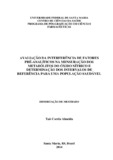| dc.creator | Almeida, Taís Corrêa | |
| dc.date.accessioned | 2015-11-03 | |
| dc.date.available | 2015-11-03 | |
| dc.date.issued | 2014-01-07 | |
| dc.identifier.citation | ALMEIDA, Taís Corrêa. EVALUATION OF INTERFERENCE FACTORS IN PRE-ANALYTICAL MEASUREMENT OF METABOLITES OF NITRIC OXIDE AND DETERMINATION OF REFERENCE INTERVALS FOR A HEALTHY
POPULATION. 2014. 80 f. Dissertação (Mestrado em Farmacologia) - Universidade Federal de Santa Maria, Santa Maria, 2014. | por |
| dc.identifier.uri | http://repositorio.ufsm.br/handle/1/6013 | |
| dc.description.abstract | Nitric oxide (NO) is a reactive free radical, that acts as a messenger molecule, mediating
several functions, including vasodilation, platelet aggregation inhibition, neurotransmission,
antimicrobial and antitumor activities. In several pathological conditions, NO is associated
with increased circulatory concentrations of cytokines and endotoxins in inflammatory
processes in especially. Because this radical to have a short half-life, its determination is
difficult, therefore, measurement of metabolites nitrite/nitrate (NOx) is most often used to
evaluate NO production. The objective of this study the effect of pre-analytical interferences
been investigating on the NOx and determine the limits of urinary and serum reference for a
healthy population. In the simulation of bilirubin, lipemia and hemolysis on serum samples,
we evaluated the pre-analytical interference in the measurement of NOx All bilirubin
concentrations used (9, 19, 38, 75, 150 and 300 mg /L), Intralipid® (0.67, 1.25, 2.5, 5 and 10
g/L) and hemoglobin (0.5, 1.0, 2.0, 4.0 and 5.0 g/L) resulted in a difference between the
original amount of NOx being checked greater than 10 percent %, thus, considered an
analytical interference. The reference limits were evaluated following the recommendations of
the International Federation of Clinical Chemistry (IFCC), and urinary values of 46.1 mmol /
L to 1533.0 mmol/L, and serum values 56.8 mmol/L at 340, 3 mmol/L for a presumably
healthy population. Thus, we conclude that bilirubin, lipemia and hemolysis interfere with the
measurement of serum activity of NOx. The reference limits were evaluated following the
recommendations of the International Federation of Clinical Chemistry (IFCC), and urinary
values of 46.1 mmol/L to 1533.0 mmol/L, and serum values 56.8 mmol/L at 340, 3 mmol/L
for a healthy population. Thus, we conclude that bilirubin, lipemia and hemolysis interfere
with the measurement of serum activity of NOx. | eng |
| dc.description.sponsorship | Coordenação de Aperfeiçoamento de Pessoal de Nível Superior | |
| dc.format | application/pdf | por |
| dc.language | por | por |
| dc.publisher | Universidade Federal de Santa Maria | por |
| dc.rights | Acesso Aberto | por |
| dc.subject | Bilirrubina | por |
| dc.subject | Hemólise | por |
| dc.subject | Interferência pré-analítica | por |
| dc.subject | Limites de referência | por |
| dc.subject | Lipemia | por |
| dc.subject | Óxido nítrico | por |
| dc.subject | Bilirubin | eng |
| dc.subject | Hemolysis | eng |
| dc.subject | Lipemia | eng |
| dc.subject | Nitric oxide | eng |
| dc.subject | Pre-analytical interference | eng |
| dc.subject | Reference limits | eng |
| dc.title | Avaliação da interferência de fatores pré-analíticos na mensuração dos metabólitos do óxido nítrico e determinação dos intervalos de referência para uma população saudável | por |
| dc.title.alternative | Evaluation of interference factors in pre-analytical measurement of metabolites of nitric oxide and determination of reference intervals for a healthy
population | eng |
| dc.type | Dissertação | por |
| dc.description.resumo | O óxido nítrico (NO) é um radical livre reativo, que age como uma molécula mensageira,
mediando diversas funções, incluindo vasodilatação, inibição da agregação plaquetária,
neurotransmissão, atividades antimicrobianas e antitumorais. Em várias condições
patológicas, o NO está associado com o aumento da concentração circulatória de citocinas e
endotoxinas especialmente em processos inflamatórios. Pelo fato deste radical possuir uma
meia-vida curta, a sua determinação torna-se difícil e, consequentemente, a mensuração de
seus metabólitos nitrito/nitrato (NOx) é mais frequentemente utilizado para avaliar a produção
de NO. Assim, o objetivo deste estudo foi investigar o efeito de interferentes pré-analíticos
sobre os níveis de NOx, bem como determinar os limites de referência urinária e sérica para
uma população saudável. Na simulação da icterícia, lipemia e hemólise em amostras séricas,
avaliou-se a interferência pré-analítica na mensuração do NOx. Todas as concentrações
utilizadas de bilirrubina (9, 19, 38, 75, 150 and 300 mg/L), de Intralipid® (0,67; 1,25; 2,5; 5 e
10 g/L) e de hemoglobina (0,5; 1,0; 2,0; 4,0 e 5,0 g/L) resultaram em uma diferença do valor
original de NOx, sendo verificada uma porcentagem maior que 10%, sendo assim,
considerada uma interferência analítica. Os limites de referência foram avaliados seguindo
recomendações da International Federation of Clinical Chemistry (IFCC), sendo os valores
urinários de 46,1 μmol/L a 1533,0 μmol/L, e os valores séricos 56,8 μmol/L a 340,3 μmol/L
para uma população saudável. Também foi possível concluir que a bilirrubina, lipemia e
hemólise causam interferência na mensuração da concentração sérica do NOx. | por |
| dc.contributor.advisor1 | Moresco, Rafael Noal | |
| dc.contributor.advisor1Lattes | http://buscatextual.cnpq.br/buscatextual/visualizacv.do?id=K4765801Z9 | por |
| dc.contributor.referee1 | Santos, Roberto Christ Vianna | |
| dc.contributor.referee1Lattes | http://lattes.cnpq.br/9176719594431835 | por |
| dc.contributor.referee2 | Vaucher, Rodrigo de Almeida | |
| dc.contributor.referee2Lattes | http://lattes.cnpq.br/0953074420467371 | por |
| dc.creator.Lattes | http://lattes.cnpq.br/0079826590014599 | por |
| dc.publisher.country | BR | por |
| dc.publisher.department | Farmácia | por |
| dc.publisher.initials | UFSM | por |
| dc.publisher.program | Programa de Pós-Graduação em Ciências Farmacêuticas | por |
| dc.subject.cnpq | CNPQ::CIENCIAS DA SAUDE::FARMACIA | por |


